General information on Horemheb’s tomb
Horemheb’s tomb at Saqqara was constructed when its owner was Generalissimo of the Egyptian armies under King Tutankhamun (1333-1323 B.C.). This means he must have been responsible for the foreign affairs of the boy-king, who died childless around the age of 18. Horemheb seems to have missed the opportunity to grasp the power then. He succeeded, however, four years later after the death of Tutankhamun’s successor, Ay. As Pharaoh, Horemheb started the construction of a new tomb in the Theban Valley of the Kings. His old tomb at Saqqara was used for the burial of his queen, Mutnodjmet. It was discovered by art robbers at the beginning of the 19th century. Various reliefs were sold to a number of European and American museums, including the RMO in Leiden. The tomb was then relocated by the Anglo-Dutch mission in 1975 and the excavations lasted until 1979. They were resumed in 1999-2000 with an inspection of the south exterior wall and its foundations, and in 2004-2006 when the expedition uncovered the forecourt and First Pylon of the tomb.
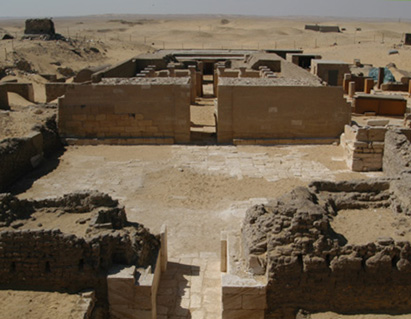
Superstructure of Horemheb’s tomb
The superstructure is about 65 m long and 20 m wide. It is built along an east-west axis and consists of a first pylon, forecourt, second pylon, outer courtyard, statue room flanked by two storerooms, inner courtyard, and three offering-chapels (the central one originally with a small pyramid on the roof). The walls are built in mudbrick. The inner wall-faces had limestone revetment with beautiful reliefs, except for the statue room, storerooms and lateral chapels which had painted scenes on mud plaster and barrel-vaults. The courtyards have peristyles of papyrus bundle columns. Extensive remains of the wall-reliefs have been preserved, especially in the entrance to the statue room and all around the second courtyard. The latter represent Horemheb being rewarded by Tutankhamun with the gold of honour (part of this scene is now in Leiden), rows of prisoners, scenes from the army camp, and funerary rites.
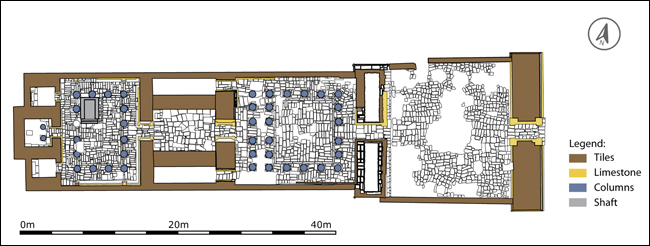
Substructure of Horemheb’s tomb
A subterranean complex opens in the floor of the inner courtyard. This comprises a 10.25 m deep shaft leading (via a second pit and corridor) to a decorated tomb-chamber for Horemheb’s first wife. A side passage gives access to another succession of vestibules and stairs, ending with a pillared hall (depth 21.09 m). This in its turn contains another shaft of 7 m depth, leading to an unfinished tomb-chamber. A female skeleton and the bones of a foetus found on the edge of the latter shaft have been identified as the remains of Mutnodjmet and her still-born child. The whole complex contained numerous fragments of the original burial gifts, including several objects with royal names. Parts of the tomb were later used for Late Period burials or as hermitages for monks of the nearby Monastery of Apa Jeremias.
Most interesting finds from Horemheb’s tomb
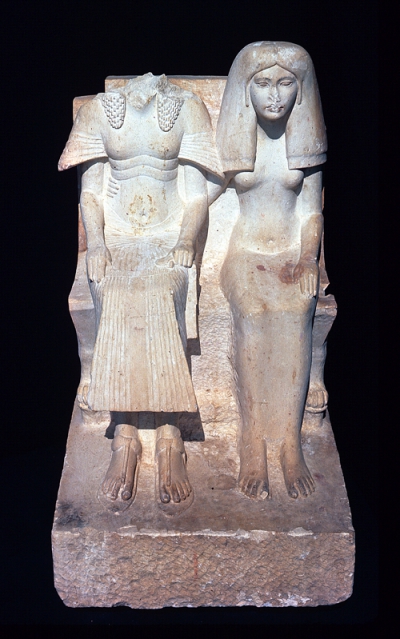 Double statue
Double statue
This dyad represents Horemheb and a woman, presumably his first wife Amenia. It was found overturned at a high level in the debris of the central offering chapel, but there is no evidence to prove that this chapel was its original provenance. The head and part of the shoulders of the male person are broken off and lost. He is represented wearing a duplex wig and a tunic with pleated sash-kilt. There is a folded piece of cloth in his left hand and there are sandals at his feet. The woman curves her right arm around her husband’s waist. She wears a plain wig and a close-fitting dress which are clearly unfinished; a lotus flower is just visible in shallow carving above the forehead. The statue is uninscribed. In spite of the fact that is was much damaged by art robbers since it was found, it is now displayed in the Luxor Museum.
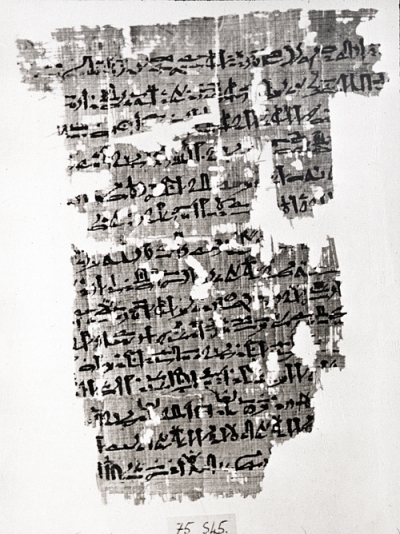 Maxims of Ani
Maxims of Ani
This fragmentary papyrus was found in 1975 in the sand and rubble of the statue room of Horemheb’s tomb. The recto is inscribed with fifteen lines of hieratic in a rather thick and clear black handwriting. The beginning and end of all lines are lost, but the page seems to be preserved to its full height. The verso is uninscribed. The importance of this papyrus is that it contains part of the literary text of the ‘Maxims of Ani’. This is the obscurest of all Egyptian wisdom texts. Several more or less complete versions are known from elsewhere, but the present copy may help to shed some light on the complex interrelationship between the preserved texts. The papyrus is written in a neat hand of the New Kingdom, probably not before the very end of the Ramesside Period. The general impression is that the text was the careful
calligraphic work of an experienced scribe.
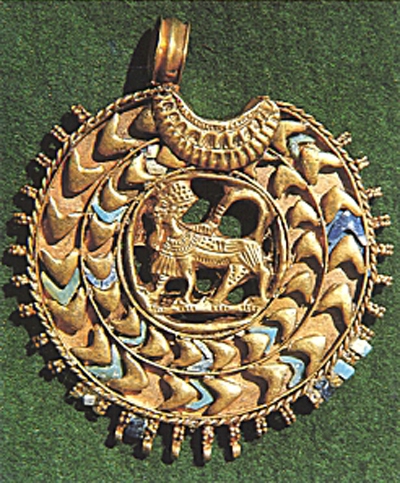 Earring
Earring
This rare item of jewellery was found in 1977 in a chamber of a shaft in Horemheb’s outer courtyard. The earring is made of solid gold. Its central element depicts a Pharaoh in the shape of a sphinx wearing the blue crown with uraeus, royal beard, and broad collar. It is surrounded by two ranges of gold chevrons, with coloured pieces made of deep blue and turquoise glass in between. The exterior edge is worked in twisted wire and granulated loops, originally with glass beads in between, and with five pendants dangling from the lower edge. The upper edge still has one of the loops of the suspension device. The earring, fortunately overlooked by robbers, can be dated to the reigns of Tutankhamun or Horemheb. It is now on display in the jewellery room of the Egyptian Museum in Cairo.
Horemheb’s Family Relations
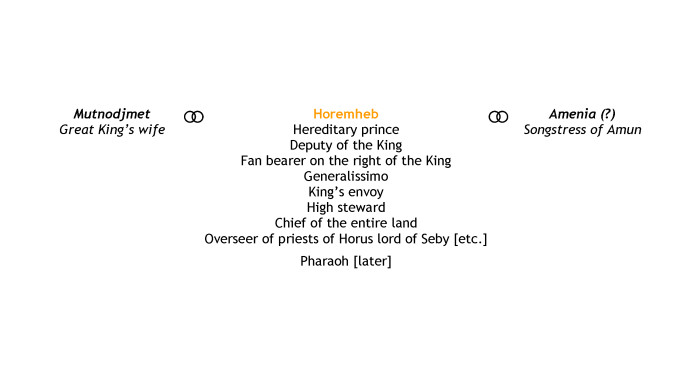
Objects from Horemheb’s tomb in museum collections
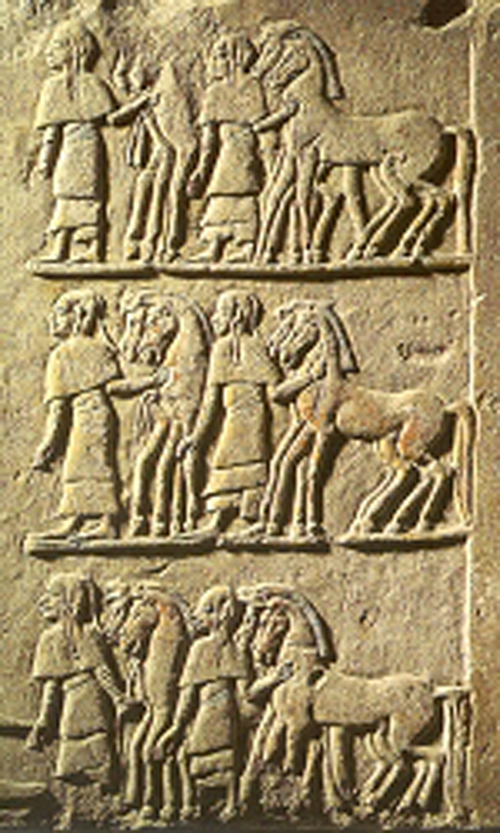
- Baltimore, Walters Art Gallery 22.128: relief
- Berlin, Ägyptisches Museum 20363: relief
- Berlin, Ägyptisches Museum 22663: relief
- Bologna, Museo Civico Archeologico 1885: relief
- Bologna, Museo Civico Archeologico 1886: relief
- Bologna, Museo Civico Archeologico 1887: relief
- Bologna, Museo Civico Archeologico 1888: relief
- Bologna, Museo Civico Archeologico 1889: relief
- Cairo, Egyptian Museum JE 11332: 3 column panels
- Cairo, Egyptian Museum JE 11334: column panel
- Cairo, Egyptian Museum T 8.6.24.20: stela fragments
- Chicago, Oriental Institute Museum 10591: relief
- Florence, Museo Archeologico 2566: relief
- Frankfurt, Liebieghaus 270: relief
- Leiden, Rijksmuseum van Oudheden, H.III.OOOO: relief
- Leiden, Rijksmuseum van Oudheden, H.III.PPPP: relief
- Leiden, Rijksmuseum van Oudheden, H.III.QQQQ: relief (see image)
- Leiden, Rijksmuseum van Oudheden, H.III.SSSS: relief
- Leiden, Rijksmuseum van Oudheden, EG-ZM3019: relief
- Leiden, Rijksmuseum van Oudheden, F 1914/4.1: relief
- Leiden, Rijksmuseum van Oudheden, AST 4: double statue
- Leiden, Rijksmuseum van Oudheden, L.X.2: kneeling statue
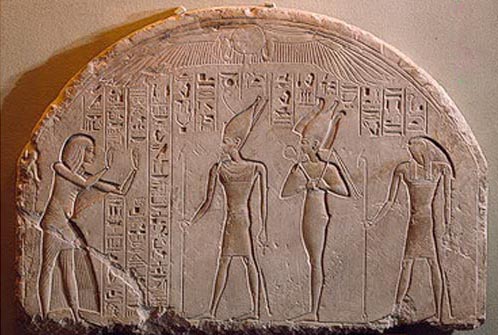 London, British Museum EA 550: pilaster
London, British Museum EA 550: pilaster- London, British Museum EA 551: stela
- London, British Museum EA 552: pilaster
- London, British Museum EA 36: double statue
- Munich, Ägyptische Sammlung 7089: relief
- New York, Brooklyn Museum 32.103: relief
- Paris, Louvre E11273: relief
- Paris, Louvre E11274: relief
- St. Petersburg, Hermitage 1061: stela fragment (see image)
- Vienna, Kunsthistorisches Museum 214: relief
Bibliography
Final report:
Martin, G.T., The Memphite Tomb of Horemheb, Commander-in-Chief of Tut’ankhamûn, I (London, 1989).
Schneider, H.D., The Memphite Tomb of Horemheb, Commander-in-Chief of Tut’ankhamûn, II: a Catalogue of the Finds (Leiden and London, 1996).
Bourriau, J.D., D.A. Aston, M.J. Raven and R. van Walsem, The Memphite Tomb of Horemheb, Commander-in-Chief of Tut’ankhamûn, III: the Pottery (London, 2005).
Strouhal, E., The Memphite Tomb of Horemheb, Commander-in-Chief of Tut’ankhamûn, IV: Human Skeletal Remains (London, 2008).
Raven, M.J., V. Verschoor, M. Vugts and R. van Walsem, The Memphite Tomb of Horemheb, Commander-in-Chief of Tutankhamun, V: The Forecourt and the Area South of the Tomb, with Some Notes on the Tomb of Tia (Turnhout, 2011).
